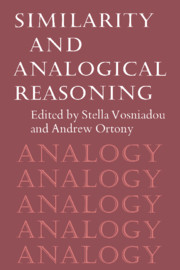Book contents
- Frontmatter
- Contents
- Preface
- List of contributors
- Similarity and analogical reasoning: a synthesis
- Part I Similarity and the structure of concepts
- 1 Similarity, typicality, and categorization
- 2 Similarity and decision making
- 3 Intraconcept similarity and its implications for interconcept similarity
- 4 Two-tiered concept meaning, inferential matching, and conceptual cohesiveness
- 5 From global similarities to kinds of similarities: the construction of dimensions in development
- 6 Comments on Part I: Psychological essentialism
- Part II Analogical reasoning
- Part III Similarity and analogy in development, learning, and instruction
- Afterword: Comments on Parts I, II, and III: A framework for a theory of comparison and mapping
- Name index
- Subject index
1 - Similarity, typicality, and categorization
Published online by Cambridge University Press: 22 October 2009
- Frontmatter
- Contents
- Preface
- List of contributors
- Similarity and analogical reasoning: a synthesis
- Part I Similarity and the structure of concepts
- 1 Similarity, typicality, and categorization
- 2 Similarity and decision making
- 3 Intraconcept similarity and its implications for interconcept similarity
- 4 Two-tiered concept meaning, inferential matching, and conceptual cohesiveness
- 5 From global similarities to kinds of similarities: the construction of dimensions in development
- 6 Comments on Part I: Psychological essentialism
- Part II Analogical reasoning
- Part III Similarity and analogy in development, learning, and instruction
- Afterword: Comments on Parts I, II, and III: A framework for a theory of comparison and mapping
- Name index
- Subject index
Summary
Here is a simple and appealing idea about the way people decide whether an object belongs to a category: The object is a member of the category if it is sufficiently similar to known category members. To put this in more cognitive terms, if you want to know whether an object is a category member, start with a representation of the object and a representation of the potential category. Then determine the similarity of the object representation to the category representation. If this similarity value is high enough, then the object belongs to the category; otherwise, it does not. For example, suppose you come across a white three-dimensional object with an elliptical profile; or suppose you read or hear a description like the one I just gave you. You can calculate a measure of the similarity between your mental representation of this object and your prior representation of categories it might fit into. Depending on the outcome of this calculation, you might decide that similarity warrants calling the object an egg, perhaps, or a turnip or a Christmas ornament.
This simple picture of categorizing seems intuitively right, especially in the context of pattern recognition. A specific egg – one you have never seen before – looks a lot like other eggs. It certainly looks more like eggs than it looks like members of most other categories. And so it is hard to escape the conclusion that something about this resemblance makes it an egg or, at least, makes us think it's one.
- Type
- Chapter
- Information
- Similarity and Analogical Reasoning , pp. 21 - 59Publisher: Cambridge University PressPrint publication year: 1989
- 240
- Cited by



